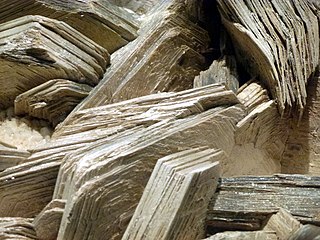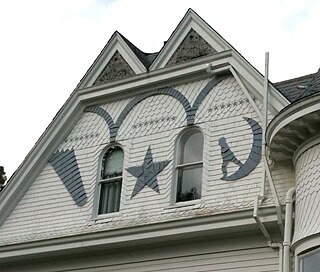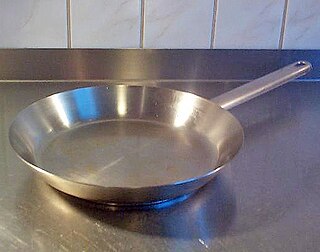
Metallurgy is a domain of materials science and engineering that studies the physical and chemical behavior of metallic elements, their inter-metallic compounds, and their mixtures, which are known as alloys.

Micas are a group of silicate minerals whose outstanding physical characteristic is that individual mica crystals can easily be split into fragile elastic plates. This characteristic is described as perfect basal cleavage. Mica is common in igneous and metamorphic rock and is occasionally found as small flakes in sedimentary rock. It is particularly prominent in many granites, pegmatites, and schists, and "books" of mica several feet across have been found in some pegmatites.

A wok is a deep round-bottomed cooking pan of Chinese origin. It is believed to be derived from the South Asian karahi. It is common in Greater China, and similar pans are found in parts of East, South and Southeast Asia, as well as being popular in other parts of the world.

Wrought iron is an iron alloy with a very low carbon content in contrast to that of cast iron. It is a semi-fused mass of iron with fibrous slag inclusions, which give it a wood-like "grain" that is visible when it is etched, rusted, or bent to failure. Wrought iron is tough, malleable, ductile, corrosion resistant, and easily forge welded, but is more difficult to weld electrically.

Anthracite, also known as hard coal and black coal, is a hard, compact variety of coal that has a submetallic lustre. It has the highest carbon content, the fewest impurities, and the highest energy density of all types of coal and is the highest ranking of coals.

Cookware and bakeware is food preparation equipment, such as cooking pots, pans, baking sheets etc. used in kitchens. Cookware is used on a stove or range cooktop, while bakeware is used in an oven. Some utensils are considered both cookware and bakeware.

Siding or wall cladding is the protective material attached to the exterior side of a wall of a house or other building. Along with the roof, it forms the first line of defense against the elements, most importantly sun, rain/snow, heat and cold, thus creating a stable, more comfortable environment on the interior side. The siding material and style also can enhance or detract from the building's beauty. There is a wide and expanding variety of materials to side with, both natural and artificial, each with its own benefits and drawbacks. Masonry walls as such do not require siding, but any wall can be sided. Walls that are internally framed, whether with wood, or steel I-beams, however, must always be sided.

A hot plate or hotplate is a heated flat surface on a stove or electric cooker on which food may be cooked, either built into an electric cooker or kitchen stove, or portable, plugged into an electric outlet.

The Belpaire firebox is a type of firebox used on steam locomotives. It was invented by Alfred Belpaire of Belgium in 1864. Today it generally refers to the shape of the outer shell of the firebox which is approximately flat at the top and square in cross-section, indicated by the longitudinal ridges on the top sides. However, it is the similar square cross-section inner firebox which provides the main advantages of this design i.e. it has a greater surface area at the top of the firebox where the heat is greatest, improving heat transfer and steam production, compared with a round-top shape.

A boiler explosion is a catastrophic failure of a boiler.

Heavy-duty cookware made of cast iron is valued for its heat retention, durability, ability to maintain high temperatures for longer time duration, and non-stick cooking when properly seasoned. Seasoning is also used to protect bare cast iron from rust. Types of cast-iron cookware include frying pans, dutch ovens, griddles, waffle irons, flattop grills, panini presses, crepe makers, deep fryers, tetsubin, woks, potjies, and karahi.

A metal roof is a roofing system featuring metal pieces or tiles exhibiting corrosion resistance, impermeability to water, and long life. It is a component of the building envelope. The metal pieces may be a covering on a structural, non-waterproof roof, or they could be self-supporting sheets.

A masonry heater is a device for warming an interior space through radiant heating, by capturing the heat from periodic burning of fuel, and then radiating the heat at a fairly constant temperature for a long period. Masonry heaters covered in tile are called Kachelofen. The technology has existed in different forms, from back into the Neoglacial and Neolithic periods. Archaeological digs have revealed excavations of ancient inhabitants utilizing hot smoke from fires in their subterranean dwellings, to radiate into the living spaces. These early forms eventually evolved into modern systems.

Alclad is a corrosion-resistant aluminium sheet formed from high-purity aluminium surface layers metallurgically bonded to high-strength aluminium alloy core material. It has a melting point of about 500 °C (932 °F). Alclad is a trademark of Alcoa but the term is also used generically.
Aluminized steel is steel that has been plated with aluminium or aluminium-silicon alloy, in a process analogous to hot-dip galvanizing. The steel workpiece is immersed in molten aluminum to produce a tight metallic bond between the steel and coating. The product has a unique combination of properties possessed by neither steel alone nor aluminium alone. Aluminized steel is more resistant to corrosion than bare steel while retaining properties of steel, at temperature lower than the melting point of aluminum, 800 °C (1,470 °F). Common applications include heat exchangers in residential furnaces, commercial rooftop HVAC units, automotive mufflers, ovens, kitchen ranges, water heaters, fireplaces, barbecue burners, and baking pans. Aluminized steel transfers heat more effectively than bare steel. It often serves where galvanized steel might have been used historically, without galvanized steel's drawbacks.

Pontypool japan is a name given to the process of japanning with the use of an oil varnish and heat, which is credited to Thomas Allgood of Pontypool. In the late 17th century, during his search for a corrosion-resistant coating for iron, he developed a recipe that included asphaltum, linseed oil and burnt umber. Once applied to metal and heated the coating turned black and was extremely tough and durable.

Parchment paper, also known as baking paper, is a cellulose-based paper whose material has been processed so as to obtain additional properties such as non-stickiness, grease resistance, resistance to humidity and heat resistance. It is commonly used in baking and cooking as a disposable non-stick paper. It is greaseproof paper that can be used for several different applications, its surface prevents the food from sticking, and also is highly heat-resistant and can be used in temperatures up to 220°C. It should not be confused with waxed paper, which is paper that has been coated with wax.

A frying pan, frypan, or skillet is a flat-bottomed pan used for frying, searing, and browning foods. It is typically 20 to 30 cm in diameter with relatively low sides that flare outwards, a long handle, and no lid. Larger pans may have a small grab handle opposite the main handle. A pan of similar dimensions, but with less flared, more vertical sides and often with a lid, is called a sauté pan. While a sauté pan can be used as a frying pan, it is designed for lower-heat cooking.
Cladding is the bonding together of dissimilar metals. It is different from fusion welding or gluing as a method to fasten the metals together. Cladding is often achieved by extruding two metals through a die as well as pressing or rolling sheets together under high pressure.

The All-Russian Institute of Light Alloys, formerly the Vils Scientific Production Association is a company based in Moscow, Russia. Rostec is the largest shareholder, controlling 39% of the institute.


















